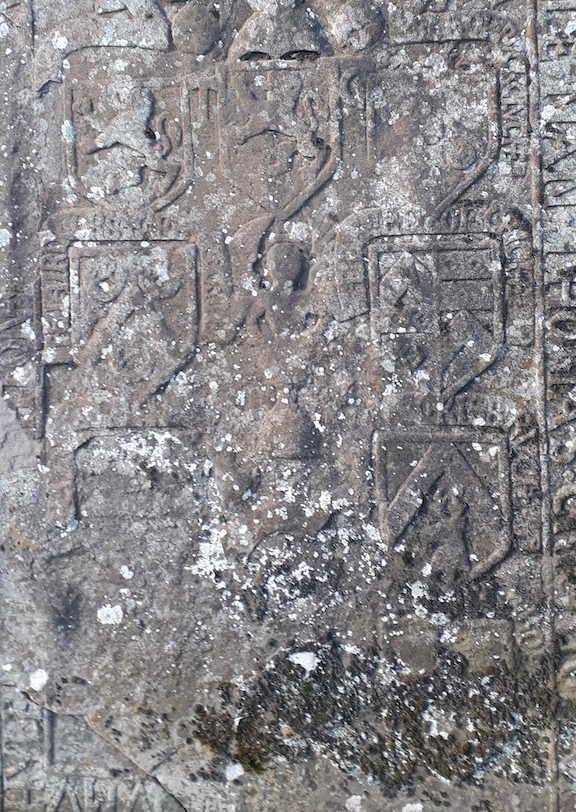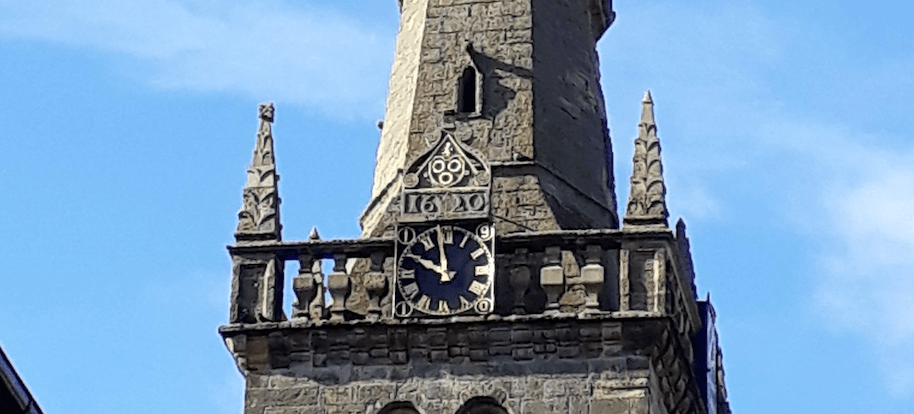The final post in the series on Alfred Huhnhäuser’s photographic archive is coming soon, but in the meantime here’s a lighter one – the fruits of some field work in Fife over the weekend.
Part of my preparatory work for the first volume of the Scottish Corpus of Carved Stones (which may or may not have exactly that title in final form) has been to undertake a visual survey of every early modern carved stone in the kingdom of Fife. This has resulted in all manner of wonderful discoveries, such as this recumbent slab currently propped against the side of the kirk in Cupar:

The inscription can be reconstructed with the assistance of a reading taken in 1933 (characters in brackets represent text legible at that time but now unreadable):

A recumbent slab with an inscribed border is probably the single most common form of early modern Scottish funeral monument, but what sets this stone apart from the ordinary are the nine coats of arms in the central panel. The scroll to the left (the viewer’s right) of the heraldic helm reads “THE MOTHERS SYD” and an equivalent inscription headed “THE FATHERS SYD” can be presumed to have once been present on the companion scroll.
What we’re seeing here are the deceased’s “probative quarters”, the arms of their eight great-grandparents. The legal and cultural practice of recording noble ancestry for a given number of generations – usually back to great- or great-great-grandparents – was common on the continent, especially the German lands, but only intermittently practiced in Scotland (for another example, see my blogpost here). In Fife it seems to have had particular currency in the early modern period, but this stone is still exceptional for dramatising its subject’s ancestral nobility in such a striking fashion.

Visible on the left hand (paternal) side are the arms of: (1) Crichton of Cranston Riddell, (2) Corstorphine of that Ilk, (3) Forrester, and (4) unreadable. On the right hand (maternal) side are those of: (5) the Earls of Buccleuch, (6) Beaton of Creich, (7) the Earls of Roxburgh, and (8) the Earls of Erroll. Any heraldically literate viewer would have been acutely aware of Thomas Crichton’s illustrious pedigree and his kinship to a series of powerful noble families across Scotland.
It is a distressing evidence of the rapid deterioration of these monuments over the course of the twentieth century that the inscription on the Crichton memorial, almost fully legible in 1933, should now be fragmentary, and that the closest analogy to this stone, the 1734 monument to John Melville in nearby Kilmany, should be completely lost, though fully legible as late as 1896. These irreversible erasures of Scotland’s artistic heritage make me all the more determined to do as much as I can to make the Corpus of Carved Stones a reality before it’s too late.

© 2019 Kelsey Jackson Williams

Leave a comment